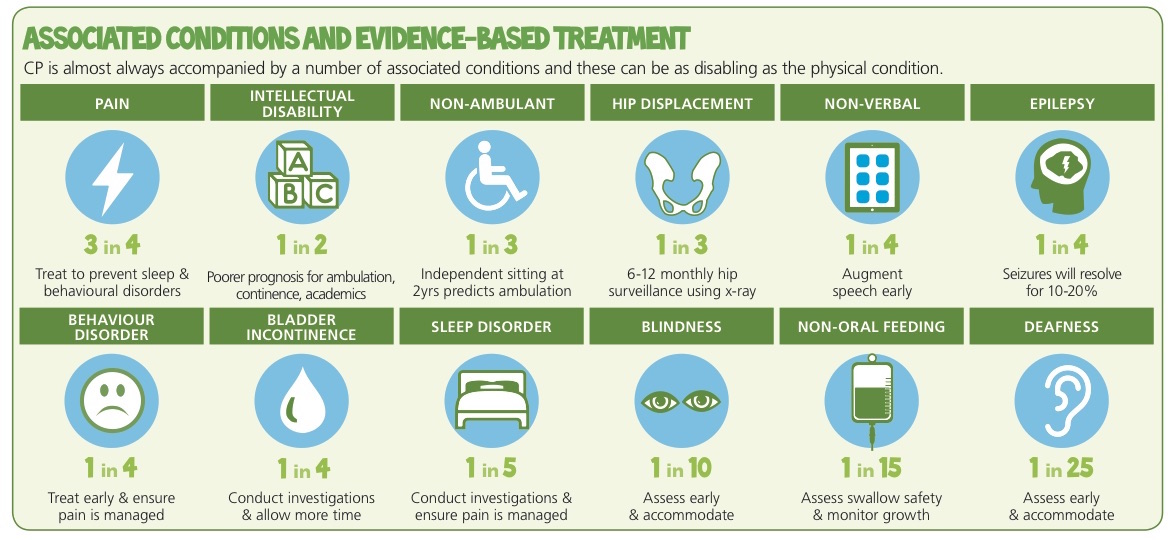Cerebral Palsy and Associated Conditions
Introduction[edit | edit source]
Children with Cerebral Palsy often have associated conditions, which are health conditions that a person has in addition to Cerebral Palsy that can have an affect on a childs child’s quality of life. Some of these conditions may be related related to Cerebral Palsy, while others are unrelated, but are commonly associated with Cerebral Palsy.
Learning Difficulties
[edit | edit source]
Children with cerebral palsy may experience specific learning difficulties due to a number of factors. Some have learning disabilities, which are neurological processing problems that interfere with basic learning skills, like reading and writing. Learning disabilities can also affect higher level skills, such as organization, sequencing and abstract reasoning. Other learning difficulties may include a short attention span, motor planning difficulties, perceptual difficulties and language difficulties.
Intellectual Difficulties
[edit | edit source]
Children with cerebral palsy vary widely in their intellectual capabilities. Some will show the same abilities as other people, despite their physical difficulties. Others will have some degree of intellectual disability, ranging from mild to significant. A child with an intellectual disability may have limitations in both Cognitive Functioning - the thinking skills that lead to knowledge and Adaptive Behavior - the ability to adapt to the environment and function in daily life. Intellectual disabilities are categorized as mild, moderate or severe.
Perceptual Difficulties[edit | edit source]
Perception is the making sense of information gained from the senses. This enables children to do things such as move around obstacles, judge size and shape of objects and understand how lines are connected to form letters. Children with perceptual difficulties have a hard time making sense of the information they take in through their eyes and/or ears, which can impact many areas of learning. For those who experience these difficulties, their problems often do not become apparent until preschool or school.
Communication / Language Difficulties
[edit | edit source]
Children with cerebral palsy may have difficulties with understanding and expressing ideas. They may require support to follow instructions, construct sentences, give specific information or tell stories that make sense. If a child is having any of these difficulties, it may have an effect on learning.
Respiratory Difficulties[edit | edit source]
Difficulties in swallowing, low activity levels, excessive drooling, blocked airways, and the inability to cough are among a few of the various reasons that children with Cerebral Palsy may experience respiratory issues. Respiratory issues have the potential to become serious conditions so monitoring breathing and respiratory function is vital.
There are numerous respiratory conditions associated with cerebral palsy, including:
Bronchitis
Pneumonia
Bronchopulmonary dysplasia
Respiratory distress syndrome (RDS)
Asthma
Aspiration
Chronic lung disease
Pneumonia, and more
Speech Difficulties
[edit | edit source]
Because the muscles of the mouth may be affected, some children may find talking difficult. For those with restricted speech, an alternative communication system may assist them (for example communication board, book or electronic device). Speech that is difficult to understand is not necessarily an indication of intellectual impairment.
Eating and Drinking Difficulties
[edit | edit source]
Cerebral palsy may affect the muscles that open and close the mouth and move the lips and the tongue. Some children may show difficulties in chewing and swallowing food and drink.
Saliva Loss[edit | edit source]
Due to poor muscle control some children with cerebral palsy may have varying degrees of saliva loss (dribbling). The dribbling may be more noticeable when they are concentrating on a fine motor task.
Vision
[edit | edit source]
Up to one in ten children with Cerebral Palsy have severe visual impairment. Up to half of all children with Spastic Cerebral Palsy have Strabismus, better known as cross-eye. Overall as many as 75 to 90 percent of children with CP have a vision impairment, including:
- Amblyopia (Lazy Eye)
- Optic Atrophy (Deterioration of the Optic Nerve due to damage)
- Nystagmus (repetitive, uncontrollable eye movements in a vertical or horizontal direction)
- Visual Field Defects (loss of one side of the visual field)
- Refractive Errors (near and farsightedness and astigmatism or blurred vision)
- Strabismus or 'Squint' where one or both eyes are turned in or out and are prevented from working together, which may lead to double vision or focusing with one eye at a time..
- Hyperopia (long-sightedness).
Hearing
[edit | edit source]
Some children with Cerebral Palsy may have hearing loss.
Epilepsy
[edit | edit source]
If this problem is present, the doctor may aim to control the seizures by choosing medicine that suits the child. It may be necessary to change the medication several times before the seizures are controlled. Sometimes they cannot be controlled.
Digestive Issues[edit | edit source]
Structural changes in the system of a child with Cerebral Palsy may lead to long term digestive issues including:
- Constipation
- Vomiting
- Aspiration
Other Associated Problems
[edit | edit source]
A systemic review was performed in order to compile information on the rates of co-occurring impairments, diseases, and functional limitations in children with cerebral palsy. Here is an overview of the results:
3 in 4 were in pain
1 in 2 had an intellectual disability
1 in 3 could not walk
1 in 3 had a hip displacement
1 in 4 could not talk
1 in 4 had epilepsy
1 in 4 had a behaviour disorder
1 in 4 had bladder control problems
1 in 5 had a sleep disorder
1 in 5 dribbled
1 in 10 were blind
1 in 15 were tube-fed
1 in 25 were deaf
You can read more about this review here.







